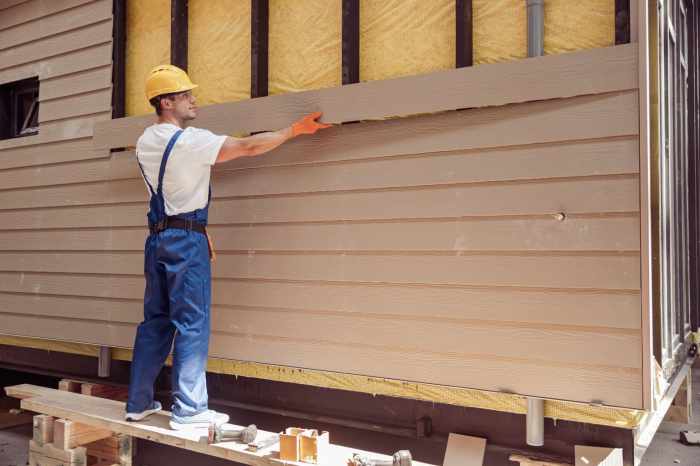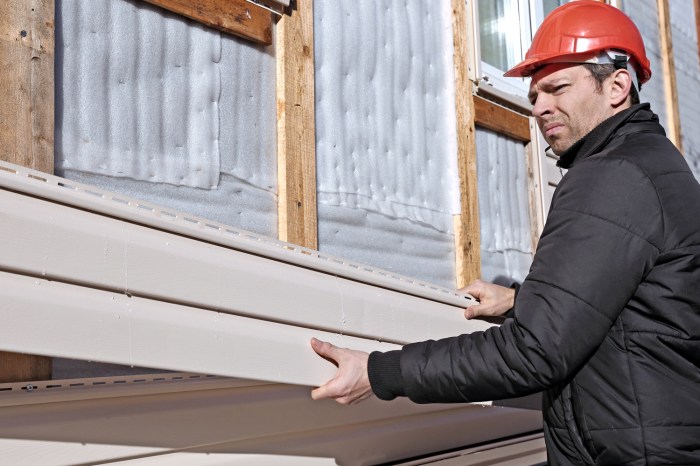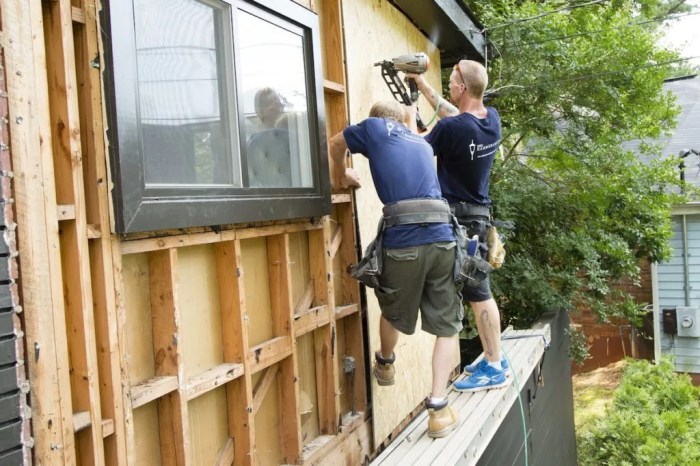The Ultimate Guide to Exterior Siding Installation
Exterior siding installation is a crucial aspect of enhancing the aesthetics and protecting the structure of your home. From choosing the right materials to proper installation techniques, this comprehensive guide dives into all you need to know about transforming the exterior of your house.
As we delve deeper into the intricacies of exterior siding installation, you'll gain valuable insights and practical tips to ensure a successful project from start to finish.
Introduction to Exterior Siding Installation
Exterior siding plays a crucial role in protecting a home from the elements, providing insulation, and enhancing the overall appearance of the property. It serves as a shield against moisture, wind, and other external factors, helping to maintain the structural integrity of the building.
Types of Exterior Siding Materials
There are various types of exterior siding materials available, each with its own unique characteristics and benefits. Some common options include:
- Vinyl Siding: Durable, low-maintenance, and cost-effective.
- Fiber Cement Siding: Resistant to fire, moisture, and pests.
- Wood Siding: Natural and aesthetically pleasing, but requires regular maintenance.
- Brick Siding: Timeless and durable, but more expensive to install.
- Stone Veneer Siding: Mimics the look of natural stone at a lower cost.
Benefits of Professional Installation vs. DIY Options
While some homeowners may consider DIY installation to save money, there are several advantages to hiring professionals for exterior siding installation:
- Expertise: Professionals have the knowledge and experience to ensure proper installation, minimizing the risk of errors.
- Time-Saving: Professional installers work efficiently and can complete the project in a timely manner.
- Quality Assurance: Professional installation comes with warranties and guarantees, providing peace of mind for homeowners.
- Safety: Handling exterior siding materials can be challenging and dangerous, so leaving it to professionals reduces the risk of accidents.
Planning for Exterior Siding Installation
Before starting the installation process of exterior siding, it is crucial to consider several key factors to ensure a smooth and successful project. Factors such as weather conditions, measuring and estimating the amount of siding needed are essential in the planning phase.
Role of Weather Conditions
Weather conditions play a significant role in the planning of exterior siding installation. Extreme temperatures, high humidity, or precipitation can impact the installation process and the performance of the siding material. It is important to schedule the installation during favorable weather conditions to prevent any potential damage or complications.
Measuring and Estimating Siding Amount
To determine the amount of siding needed for a project, accurate measurements of the exterior walls are essential. Measure the height and width of each wall to calculate the total square footage. Consider any openings such as doors and windows when estimating the amount of siding required.
It is recommended to add an extra 10% to account for any waste or cutting errors during installation.
Preparation for Exterior Siding Installation

Before diving into the actual installation of exterior siding, it is crucial to properly prepare the exterior walls to ensure a successful and long-lasting outcome. This involves gathering the necessary tools and equipment, as well as addressing key aspects such as insulation and moisture barriers.
Tools and Equipment
- Siding materials
- Tape measure
- Level
- Caulk gun
- Hammer or nail gun
- Saw
- Utility knife
- Ladder or scaffolding
- Protective gear
Preparing Exterior Walls
Prior to installing the siding, the exterior walls must be properly prepared. Here is a step-by-step guide:
- Clean the walls thoroughly to remove dirt, debris, and any existing finish.
- Repair any damaged areas, such as holes or cracks, and ensure the surface is smooth.
- Apply a moisture barrier to prevent water infiltration and protect the structure.
- Install insulation to improve energy efficiency and regulate indoor temperature.
- Add furring strips or sheathing to create a flat surface for the siding installation.
Importance of Insulation and Moisture Barriers
Proper insulation and moisture barriers play a vital role in the longevity and performance of exterior siding. Insulation helps reduce energy costs by keeping the home insulated, while moisture barriers prevent water damage and mold growth.
Installing Exterior Siding
When it comes to installing exterior siding, there are different techniques depending on the type of material being used. Proper installation is crucial for the overall durability and appearance of your home's exterior.
Techniques for Installing Various Types of Siding Materials
- Vinyl Siding: Start at the bottom and work your way up, overlapping each piece to prevent water infiltration. Use nails to secure the siding to the wall, allowing for expansion and contraction.
- Fiber Cement Siding: Cut the siding with a special blade to prevent chipping. Install the siding with the appropriate gap for expansion and use stainless steel nails for fastening.
- Wood Siding: Ensure proper sealing and priming of the wood before installation to prevent rot. Use a nail gun or hammer to secure the siding, making sure to leave space for movement.
Best Practices for Cutting and Fitting Siding Pieces
It is essential to measure and cut siding pieces accurately to ensure a seamless and professional finish. Use a sharp utility knife, circular saw, or specialized siding cutter for precise cuts. Always follow the manufacturer's guidelines for cutting and fitting each type of siding material.
Securing Siding Properly for Durability and Longevity
- Use the correct type and length of nails recommended by the siding manufacturer to secure the siding properly.
- Ensure that the siding is installed with the right amount of overlap and spacing to allow for expansion and contraction with changes in temperature.
- Seal all joints and edges with caulk or sealant to prevent moisture infiltration and protect the underlying structure from damage.
Finishing Touches and Maintenance

After completing the installation of your exterior siding, it's essential to focus on the finishing touches and maintenance to ensure the longevity and aesthetics of your home's exterior.
Finishing Steps
- Apply caulking: Seal any gaps or joints between siding panels with a high-quality caulking material to prevent water infiltration and maintain energy efficiency.
- Paint or stain: Depending on the type of siding material used, consider painting or staining the exterior to enhance its appearance and provide an extra layer of protection against the elements.
- Inspect for any touch-ups: Walk around your home and inspect the siding for any imperfections or areas that may need additional attention, such as re-nailing loose panels or replacing damaged pieces.
Maintenance Tips
- Regular cleaning: Keep your siding clean by washing it with a mild detergent and water to remove dirt, mold, and mildew buildup that can compromise its integrity.
- Trim vegetation: Trim any overgrown plants or trees near the siding to prevent damage from branches rubbing against the surface or moisture retention that can lead to rot.
- Inspect for damage: Periodically inspect your siding for signs of damage, such as cracks, warping, or discoloration, and address any issues promptly to prevent further deterioration.
Common Issues and Solutions
- Moisture problems: Address any moisture issues promptly to prevent mold growth and rot by improving drainage around your home and ensuring proper ventilation.
- Fading or peeling paint: If you notice fading or peeling paint on your siding, consider repainting the affected areas with a high-quality exterior paint to restore its appearance and protect the surface.
- Pest infestations: Take preventive measures to deter pests, such as insects or rodents, from nesting in or damaging your siding by sealing entry points and using pest control methods.
Last Word

In conclusion, mastering the art of exterior siding installation not only elevates the curb appeal of your home but also enhances its durability and functionality. With the knowledge and guidelines provided in this guide, you're now equipped to tackle this home improvement project with confidence.
FAQ Section
What are the benefits of professional installation over DIY?
Professional installation ensures precision, expertise, and often comes with warranties, while DIY may save costs but requires time and skill.
How do weather conditions impact siding installation?
Extreme weather can affect the process, so it's crucial to plan around favorable conditions to ensure optimal results.
What are the common maintenance tips for exterior siding?
Regular cleaning, inspection for damage, and prompt repairs are key to extending the lifespan of your exterior siding.




